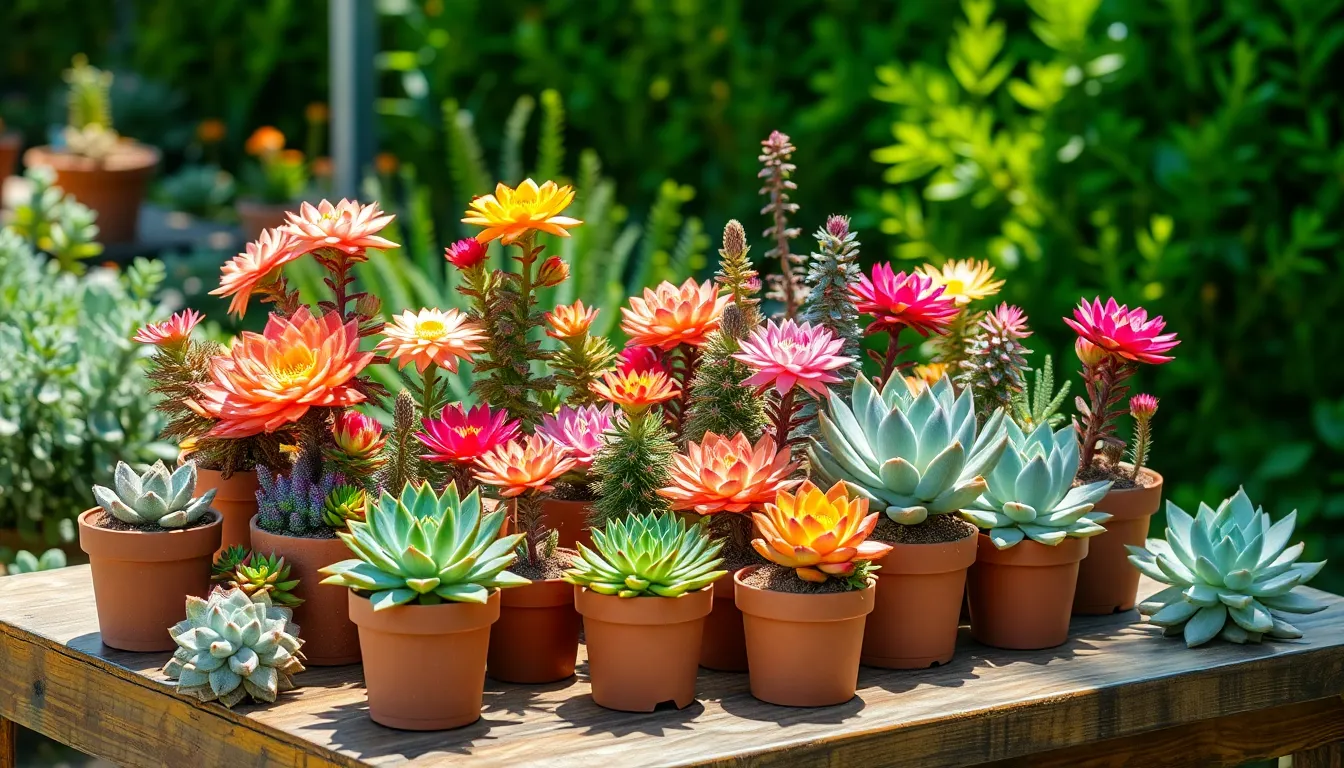
Blooming Succulents: Discover the Hidden Beauty and Care Tips for Vibrant Plants
Succulents are the rock stars of the plant world, known for their quirky shapes and low-maintenance charm. But wait—there’s more! When these little green wonders decide to bloom, they unleash a spectacular show that’ll make even the most seasoned gardener do a double-take. Imagine a tiny cactus strutting its colorful flowers like it’s on a catwalk—who knew they had it in them?
Blooming Succulents
Blooming succulents add unexpected beauty to gardens and indoor spaces. These plants display vibrant flowers, captivating both novice and seasoned gardeners.
What Are Succulents?
Succulents are plants that store water in their leaves, stems, or roots. This unique adaptation allows them to thrive in arid environments. Common examples include Aloe, Echeveria, and Sedum. Various species exhibit diverse shapes, sizes, and colors, showcasing a wide range of aesthetic options. With their low water requirements and hardy nature, succulents appeal to busy individuals and those new to gardening alike.
Types of Blooming Succulents
Several succulents bloom, each offering distinctive flowers. Echeveria, for instance, produces rosettes with vibrant tubular blooms. Kalanchoe showcases clusters of small, colorful flowers that can last for weeks. Agave, known for its stunning floral spikes, can bloom once in a lifetime. Finally, some varieties of Sedum produce tiny, star-like blossoms that attract pollinators. Each type enhances the visual appeal of gardens and planters, elevating the overall landscape.
Factors Influencing Blooms

Succulents blossom when specific conditions are met. Understanding these factors can enhance the chances of vibrant blooms.
Light Requirements
Adequate light plays a crucial role in the blooming process. Succulents typically thrive under bright, indirect sunlight for six to eight hours daily. Insufficient light can hinder flower production, leading to weaker growth. Conversely, too much direct sunlight may scorch the leaves. Each succulent species has particular lighting preferences; for example, Echeveria enjoys brighter conditions, while some varieties of Sedum prefer partial shade. Adjusting the light exposure ensures optimal blooming while maintaining healthy foliage.
Watering Practices
Proper watering significantly affects blooming in succulents. Overwatering leads to root rot, a common issue that inhibits flower formation. In contrast, underwatering causes stress, stunting growth and bloom potential. It’s essential to let the soil dry out completely between watering sessions. When watering, a thorough soak encourages deep root growth. Additionally, some succulents benefit from reduced watering periods during the dormant phase to promote stronger blooms in the growing season. Tailoring watering practices to individual species supports not only healthier plants but also enhances the likelihood of stunning flowers.
Care Tips for Blooming Succulents
Proper care enhances the beauty of blooming succulents. Attention to soil and pruning techniques significantly boosts blooming potential.
Soil Recommendations
Soil selection plays a vital role in the health of succulents. A well-draining, sandy mix suits most species, allowing excess water to escape. Incorporating perlite or pumice aids in aeration, reducing the risk of root rot. When selecting a pot, ensure it has drainage holes to facilitate proper moisture control. The pH level should hover around 6 to 7, promoting optimal nutrient availability. Checking the soil regularly helps identify when it needs refreshing. Many gardeners blend commercial cactus soil with organic matter for better results.
Pruning Techniques
Pruning contributes to the healthy growth of succulents and encourages blooming. Removing dead or faded flowers prevents energy loss, redirecting nutrients to healthier parts. A clean, sharp pair of scissors or shears simplifies the process, minimizing damage to the plant. Cutting back leggy growth enhances the plant’s overall shape and encourages the development of new blooms. Engaging with the layers of the plant as it grows reveals botanical beauty. Timing pruning during the dormant season generally supports quicker recovery and promotes new growth. Keeping an eye on pests and trimming infested leaves is crucial for maintaining plant health.
Popular Blooming Succulents to Consider
Blooming succulents add vibrant colors and unique shapes to gardens. Here are some popular varieties to consider.
Echeveria
Echeveria succulents produce stunning, tubular flowers that attract attention. These plants come in various colors, including pink, red, and orange. They thrive in bright, indirect sunlight for six to eight hours each day, promoting abundant blooms. Echeveria prefers well-draining soil to avoid root rot, enhancing its blooming potential. Regular watering practices help keep them healthy, allowing soil to dry completely between sessions. Pruning dead flowers encourages new growth and directs energy toward blooming. Many gardeners appreciate their resilience and beauty, making Echeveria a top choice for both indoor and outdoor displays.
Haworthia
Haworthia exhibits striking, rosette-shaped leaves that capture interest. This succulent blooms with small, tubular flowers on tall spikes, often white or pale pink. Adaptable to lower light conditions, it thrives under bright, indirect light, making it suitable for indoors. Maintaining a well-draining soil mix is crucial to its growth, as overwatering can prevent blooming. Water thoroughly, then allow the soil to dry between sessions for optimal results. Pruning faded flowers can stimulate new blooms and maintain plant health. Many enthusiasts enjoy incorporating Haworthia into their collections due to its unique appearance and relatively easy care requirements.
Conclusion
Blooming succulents bring a unique charm to any garden or indoor space. Their vibrant flowers not only surprise but also enhance the overall aesthetic. With the right care including proper light and watering practices, these resilient plants can thrive and showcase their stunning blooms.
Choosing popular varieties like Echeveria and Haworthia allows gardeners to enjoy both beauty and ease of maintenance. By understanding the specific needs of each succulent type, anyone can cultivate a thriving collection that flourishes year-round. Embracing the unexpected beauty of blooming succulents can transform any environment into a vibrant oasis.
